Latin Is A Dead Language Anyway
“An article last Thursday about a couple’s 704-square-foot home referred incorrectly to the organisms found on the roof. They are plants, which makes them flora, not fauna.”
The Armored, Possibly Dinosaur-Eating "Devil Frog"

Hello, class, and welcome to Today In Frogs. Today’s frog is called the Devil Frog, by scientists, for real. Above you will find an artist’s rendering of it eating a dinosaur (?) (!).
The Devil Frog, Beelzebufo ampinga, lived about 70 million years ago in Gondwana (fossils are now found mostly in Madagascar). Back in 2008, some scientists decided it was the biggest frog that ever lived, the size of a “squashed beach ball,” which apparently is about 16 inches long, and that it probably ate baby dinosaurs. An artist promptly drew that picture of a frog eating a dinosaur, thank you artist.
The newest study of it, published this week in the journal PLOS One, found that it’s weirder than expected; you know you’re dealing with a real weird animal when scientists describe it with phrases like “it was mostly a mouth.” Armored like a turtle, too heavy to hop, with big scary horns on its head and mean sharp teeth, the Devil Frog’s newly reconstructed skeleton makes it unlikely that the frog really moved that much; it probably buried itself and then used its giant scary mouth to grab whatever came by.
Unfortunately, that may not have been dinosaurs; of the five skeletons used in the new study, none were bigger than about 10 inches. But that’s only five Devil Frogs, so who knows, really. Here’s what a reconstructed skeleton looks like:
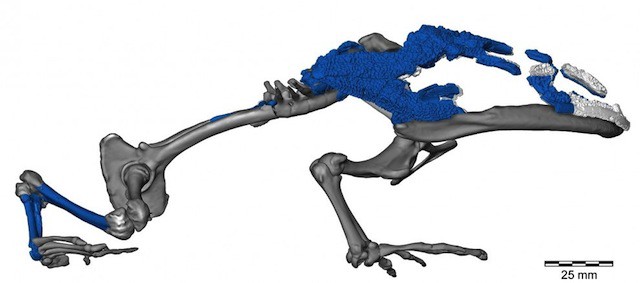
GAAAAAAAAH.
Top image by Nobu Tamura. Bottom image by Evans et al.
"We Create Community And We Create Space"
I ask myself everyday, why am I doing what I am doing, and what does it matter? Let work flow from there.
— Latoya Peterson (@LatoyaPeterson) January 29, 2014
The Day The Polar Bear Learned About Snow
There is an old joke that goes something like this: One morning a polar bear cub is awakened by his parents so early in the day that the sky is still dark.
“Get up, get up,” say the parents. “Today you learn to swim.”
So the polar bear cub spends his day going in and out of the frigid water, in and out until finally the sky is dark again and he comes back home.
“Mom,” he says, “can I ask you a question?”
“Of course,” she answers.
“Am I a polar bear?”
“Of course you are,” she replies.
“Okay,” he says.
The next morning the polar bear cub is awakened by his parents so early in the day that the snowy owl is still hooting in its tree.
“Get up, get up,” say the parents. “Today you learn to fish.”
So the polar bear cub spends his day going in and out of the frigid water, waiting on the cold ice until a fish swims by and diving into the bitter depths when he sees one, until finally the owl starts to hoot again and he goes home.
“Mom,” he says, “can I ask you a question?”
“Of course,” she answers.
“Am I a polar bear?”
“Of course you are,” she replies.
“Okay,” he says.
It hardly seems as if he has put his head down to rest before the polar bear cub is again awakened by his parents.
“Get up, get up,” say the parents. “Today you learn to hunt.”
So the polar bear cub spends his day stalking and running over the ice, waiting for walruses in the cold and occasionally diving down into the blue depths to hide and surprise his prey. When he feels as if all he has left in him is the energy to get home he finally drags himself back to where his parents are waiting.
“Mom,” he says, “can I ask you a question?”
“Of course,” she answers.
“Am I a polar bear?”
“Of course you are,” she replies.
“Okay,” he says.
The polar bear’s father looks over at him.
“Son,” he says, “every day for the last three days you have been asking us, ‘Am I a polar bear?’ Well, I’m a polar bear. Your mother is a polar bear. All of our parents were polar bears. You come from a line of polar bears stretching back to when polar bears first ran across this ice. Why do you keep asking if you’re a polar bear?”
A little tear forms in the polar bear cub’s eye as he looks squarely at his parents.
“Because,” he says, “I’m fucking freezing.”
Forget It, Jake, It's Kristallnacht

“Five days on, the commentariat continues to drop anvils on Tom Perkins, who may have written the most-read letter to the editor in the history of The Wall Street Journal. The irony is that the vituperation is making our friend’s point about liberal intolerance — maybe better than he did.”
I Was A Love-Letter Ghostwriter
by Bonnie Downing
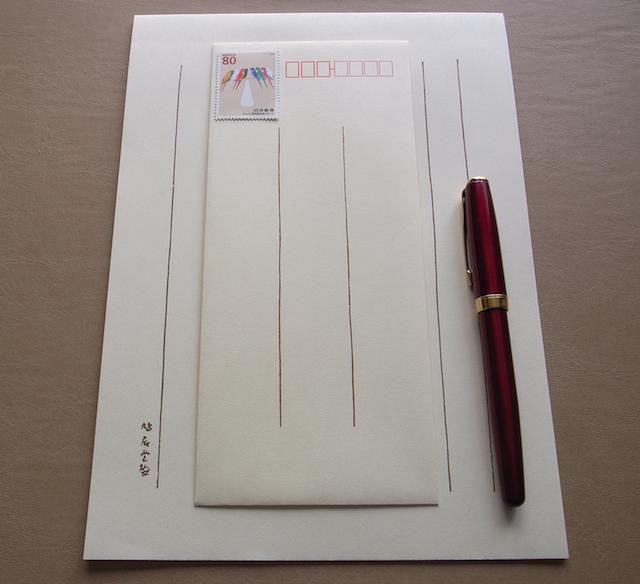
Nine years ago, I answered an ad on Craigslist and was hired by artist Jana Leo de Blas. Jana was a tiny woman of indeterminable age with a dandelion puff of hair. I arrived at her bright, high-ceilinged studio in the old I.S.C.P. building in midtown Manhattan; she had built a platform in the middle of the room. I climbed the few steps, settled at the desk with my laptop and coffee and tried to remember some poetry to quote in case I choked. That morning was the start of a weekend of open studios, but Jana wanted to be sure we didn’t limit ourselves to visiting art fans, so she left me there and took to the streets with invitations.
Her piece was called the Love Letter Project, and my first client, a middle-aged man, seemed game in the way that people get during open studio events. I saw Jana’s point. He sat down across the desk from me, and pursed his lips, humming around for an idea.
“Who do you love?” I asked. He laughed.
“Does it have to be a romantic love?”
“No,” I said.
“Well, I have an idea,” he said. “My son is leaving for college soon, and I’d like to write a letter to his mother, my ex-wife.” He was proud of how they had managed co-parenting, though they had both remarried. He was glad they remained close friends. I took notes as he spoke. This was an easy start, more of a friendly note really. “I worry that our connection takes away from what I have with my new wife.” He began to cry. “I still love her,” he said. He wished they had never divorced.
I listened until he was finished talking. Then I arranged the sentences he’d spoken on the page. It was more like transcribing than writing.

At the front of the room was a small table with a printer, envelopes, pens and stamps. “You may sign your letter,” Jana told him and he did. “Would you like a stamp so you can mail it? Or we can mail it for you.” He took the stamp and addressed the envelope, but wasn’t quite committed enough to let us mail it. His feelings had been so close to the surface. We had happened to catch him at the perfect moment.
But it kept happening like that.
A young woman, too shy to make eye contact, sat down and said we could do a letter to her best friend, she guessed. She seemed skeptical and confused about the project and proved to be a tough interview at first. Would she tell me about her friend? “She’s nice.” What did the two of them do together? “Like, hang out.” Could she tell me about a private joke between them, a special phrase, even if she didn’t want to tell me what it meant? She shrugged. And then something shifted and she said she was in love with her friend, had just realized she was gay, and she didn’t know how to tell anyone, especially the most important person.
Again I wrote the letter simply, using mostly her own words. One phrase she used, awkward and perfect, made the letter.

Artists had come from around the world for this residency, so the open studios weekend drew an international crowd. More than once, visitors apologized for their imperfect English and asked me to “fix it.” But idiosyncrasies are important in a love letter. The words should sound like the sender speaking. It seemed very important to preserve that authentic rhythm.
Writing about Spike Jonze’s film Her, whose hero is a professional ghostwriter of love letters, Maria Bustillos found the very concept of ghostwritten letters absurd. “Wouldn’t this be about five zillion times worse than receiving no letter at all?” she asked. I kept thinking about this, because as much as I loved doing it, I would hate to receive outsourced sentiment.
The concept is not as new as it feels in the film, or as new as it felt to me nine years ago as part of an eccentric art project. Mix tapes or playlists are a type of ghostwritten love letter, in which lyrics “speak” for the sender. (I mean here the ones made by a love interest or a dear friend, not the BPM to MPH ones shared by running partners.) If someone you like tells you a song reminds them of you, you feel flattered, maybe moved, assuming the lyrics are romantic, hot and/or sad enough. You don’t need to believe that the person presenting the song to you wrote those lyrics for the magic to work.
And love letters themselves often have a ghostwritten section. The line or stanza of quoted poetry, dropped into the scrawling of a barely literate suitor, sometimes works to lend the sender depth — or to provide him with an apt expression he would be incapable of minting.
I should mention Cyrano, but he was already in love with Roxane by the time he started writing to her. “Modern-day Cyranos” as well have been popping up in the press over the past decade or so. These online dating assistants not only create attractive profile content but also correspond with potential dates. But that’s just marketing.
Jennie Erdal’s 2006 memoir, Ghosting, recounts the twenty years she spent as a ghostwriter, and begins with a love letter she ghostwrote to her boss’s wife. In a 2010 episode of the TV show, “Bones,” a love-letter ghostwriter is murdered when the recipient finds out the truth. President Obama was accused of sending ghostwritten love letters to an old girlfriend after an excerpt of his memoir was published in Vanity Fair and Jack Cashill took an obsessively close look at the syntax.
Requests for ghostwritten love letters are not uncommon on sites like Elance, oDesk and Guru, online marketplaces where writers and others bid on virtual assignments.

This month saw the release of a ghostwritten love app, Romantimatic, which allows users to schedule loving texts to their significant other. Creator Greg Knauss responded to criticism of the concept, and especially of the included generic messages: “We’ve wrapped code around almost everything in our lives, but deeply felt emotion is still supposed to be start-to-finish analog.” In other words, love should be expressed in BeautifulHandwrittenLetters. Knauss denied that the app came from a place of cynicism, describing himself as “a boiling cauldron of passionate love.”
The people who let me write ghostwrite their love letters were boiling cauldrons, too. Even the ones — especially the ones — who walked in on a whim and expected a joke. Most told me they had not planned on writing a letter and did not usually write love letters.
My family has sent me loving yet ghostwritten letters all my life. I get funny animal birthday cards from my Dad, and the fancy kind with an extra layer of colored paper inside from my favorite aunt. Paul Hiebert examines this socially acceptable cheat in his recent piece in the Pacific Standard, “The Emotional Outsourcing of the Greeting Card.” The Victorians and Edwardians loved to exchange decorated poetry cards.
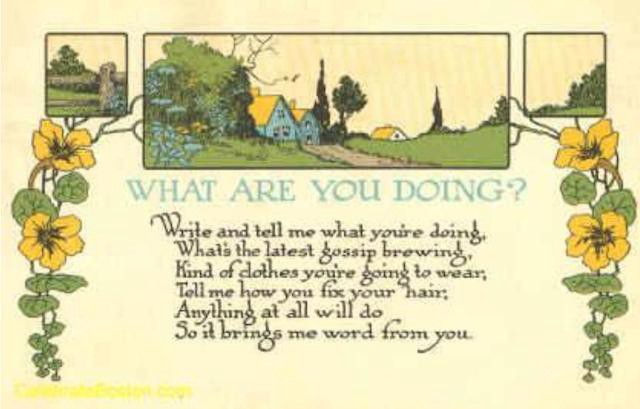
Esther Howland began producing commercial Valentine’s Day cards in the U.S. in the mid-1800s, and the greeting card business boomed through the twentieth century. Hallmark reports selling about 140 million Valentines Day cards each year.
Though the card industry has declined since the rise of the internet, the popularity of ghostwritten love letters has not. E-card businesses sell pre-written love notes for subscription fees. Facebook is littered with cloying memes demanding to be shared and re-posted, “If you’re lucky enough to have a friend like this!”
In 1946, social anthropologist William E. Henry observed women choosing from a variety of greeting cards and published his findings in, “Art and Cultural Symbolism: A Psychological Study of Greeting Cards.” He was particularly fascinated by one subject, Mrs. G, a “competent, efficient career woman.”
“She has her own career, she can keep up with the best of her men business associates. She dresses severely in tailored clothes and simple hats. One might suppose that her selection of greeting cards would be similarly plain and severe, unromantic, unsentimental. But this was not the case. There was another element to Mrs. G’s personality seen in our test material. She was lonely, profoundly lonely… she longed to be able to express the sentiments she felt. And in every channel where she was allowed be sentimental without losing her facade of efficiency, she did so. While she received birthday presents appropriate to her facade, cigarettes, subscriptions to business magazines, and the like, she sent to others flowers, candy, and romantic books. And she selected the sentimental greeting cards.”
When people came to me for letters with big googly eyes and immediately gushed about just how in love they were with snookums, my job was less interesting. It was the ones that seemed a little cold on first impression, the ones like Mrs. G, who later cracked the widest and said the things I still think about.
I wrote more than one breakup letter that weekend. One woman looked displeased as she read her printout, but then she told me that yes, she thought it would do. She planned to leave the letter on the table.

I tried to coax imagery from my clients. When someone described a girlfriend as beautiful, I asked him to describe her in a certain moment. He said she looked so lovely when she held a baby. That was better. Some people really delivered.

There’s a passage in that same letter that may very well be about an operating system. I know what I have done. I made you into a perfect character. Nothing has happened so nothing is disappointing me. You are separate from reality.
I spent my time as a ghostwriter in flow state, losing myself in listening. I felt I could stay up on that perch forever. My baseline intense curiosity joined with a desire to honor the trust people put in me. Is this what it was like for therapists? Of course what I was doing was nothing like therapy, but I saw the power of simply listening and validating. Handing over the letter was akin to that annoying things that therapists do: so I’m hearing that you feel…
I lost touch with Jana for years and when I looked her up I found other people’s love letter projects all over the Internet. One project is a series of love-themed murals. Blogs request letters for people who are suffering. Artists leave love letters in public places to be found by random strangers. Coaches encourage followers to write a love letter to themselves every day, to improve self-esteem. A random letter seems worse than getting a ghostwritten one.
Jana herself is still active in the niche profession. Last year in Madrid, she worked on La Oficina Del Amor, an art project commissioned by the Cervantes Institute. Her “Love Office” is a “virtual archive of words to assist personal relationships. This is a support tool that helps to write an ad (for) those unskilled in handling the language of love.”
As moved as I was by the people who mailed their letters (some even let us mail them!), the one I think about most often was a quiet, dark-haired woman. We asked each participant for permission to print an extra copy, for an exhibit that Jana went on to show in galleries. Only one woman declined. She didn’t want anyone else to read her letter, even without any identifying details. And did she plan to give the letter to the person to whom it was written? No, she said. She would never, ever give it to him. She would hide it and once in a while, she would take it out and read it, alone.
“I know where,” she said. “I’ll keep it way in the back. In the drawer.”
Bonnie Downing haunts Brooklyn and Twitter @bonnie_downing. Jana Leo de Blas holds the copyright to The Love Letter Project and the content of the letters above. More about Jana and her current projects is here. Ave Carillo produced a piece on the project for Studio 360. Top photo by Toshiyuki IMAI./
New York City to Newark to New York City, January 28, 2014
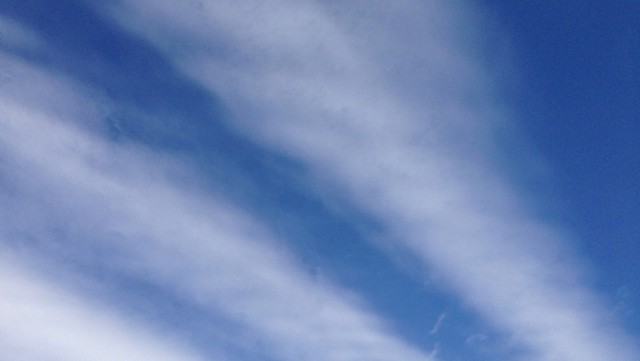
★★ Ice was floating down the Hudson again; cirrus clouds were moving north quickly. On the subway platform, a woman wearing a small dog in a baby sling dabbed at her nose. Rumpled synthetic fleece blankets marked the presence of babies. Or dogs? A grainy translucent slush puddle at the gutter was as unyielding as steel plate. A cafe had left drinking glasses on its sidewalk tables, in case a flaneur in triple longjohns might want a place setting, and one glass had been knocked down and smashed. The early clarity gave way to gloom again. At night, in the dark outside the train, lights gleamed on the frozen marshes or parking lots of New Jersey. The sidewalk through the new Newark, from Penn Station to the performing-arts complex, was solid ice, innocent of salt or shovel. The sky was mud-orange, with a descending airplane passing across it.
Why Brush Your Teeth With Chocolate When You Can Brush Your Teeth With California Wine or Bamboo
by Jeva Lange
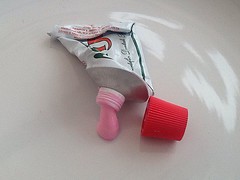
Yesterday Crest announced the launch of new toothpaste flavors “Mint Chocolate Trek,” “Vanilla Mint Spark” and “Lime Spearmint Zest,” all of which are soooo boring if you know anything at all about the Wonderful World of Toothpaste Flavors.
Here is a list of actual toothpastes that you can put in your mouth in the furtherance of dental cleanliness. Never brush with boredom again.
• Bamboo
• Indian curry
• “Contains radioactive compound”
• Scotch
• California wine, including Chablis, Burgundy and Extra-dry Champagne flavors
• Crème de Café
• Irish cream
• Peppermint schnapps
• Foaming beer
• Green tea
• Pumpkin pudding
• Cupcake
• Tropical pine
• Cola
• Fresh yoghurt
• Honey
• White peach
• Kyoto Matcha
• Caramel
• “Lightly Salted”
• Kiwi
• Kishu Plum
• Pomegranate
• Lavender
• Grapefruit
• Bacon
• Nihilist (“No flavor. No color. Nothing. Like brushing your teeth with reality.”)
• Pickle
• Ginger mint
• Cinnamon mint
• Jasmine mint
• Licorice
• Coffee
• Eggplant
• Octopus
[Sources include this toothpaste world record holder, this store, this store, this store, this ebay sale, and this photo. The pink toothpaste photo is tarrytown’s.]
Suck It, Monkeys, Bears Rule
“There was a time when the Super Bowl was not only synonymous with funny advertising, but synonymous with funny monkey advertising. Now, it looks like bears may be taking monkeys’ place.”
